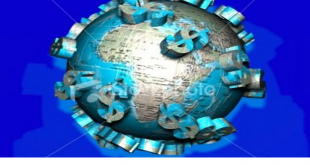America has caught a whiff of a changing world. CIA Director William Burns has grudgingly acknowledged that “the United States… is no longer the only big kid on the geopolitical bloc. And our position at the head of the table isn’t guaranteed.” But America’s dogmatic inability to see past its old paradigm has prevented it from understanding that change. The United States has drifted outside the geopolitical current.
Russia, China and India insist that multipolarity is not a goal on the distant horizon but a current reality. “The trend toward multipolarity in the world is inevitable. It will only intensify. And those who do not understand this and do not follow this trend will lose,” Putin has said. Russian Foreign Minister Sergey Lavrov has called multipolarity “a fact, a geopolitical reality.” “The landscape,” India’s External Affairs Minister Subrahmanyam Jaishankar agrees “has now changed irreversibly.”
But in its inability to adapt, the U.S. clings to the battle to prevent the unipolar world’s slip back into bipolarity. The U.S. remains capable only of seeing a world divided into two blocs: it sees every nation that accepts its hegemony as one bloc and every nonaligned nation in the multipolar world that refuses to choose between two sides as the other bloc. The U.S. is incapable of seeing past the bipolar world and mistakes the multipolar reality as the other bloc in a bipolar world.
That is a misconception that prevents the U.S. from aligning itself with the inevitable new reality of the international order. Being unaligned with reality has frustrated American foreign policy.
In the outdated American model, India, the largest country in the world and a growing power, is the weight whose choice of sides will determine which block prevails. Long a partner of the U.S. and a key friend of Russia, India has a foot in both blocs of the world as the U.S. sees it. Bringing India fully into the American camp is a key to U.S. foreign policy.
But the members of the emerging multipolar world do not see the new world as one in which they have to choose sides. The U.S. continues to woo countries with gifts and to threaten countries with sanctions to seduce them into exclusive partnerships. But the outdated U.S. worldview restricts it to desperately courting countries into exclusive relationships that their worldview no longer allows them to enter into.
The nonaligned nations are taking a side: not between the U.S. on one side and Russia and China on the other but between a monogamous U.S. unipolar worldview and an uncommitted Russia-China world view that allows countries to pursue multiple relationships in pursuit of their own interests, not the interests of the hegemon they follow. The nonaligned nations have not chosen Russia or China over the United States: they have chosen the Russia-China worldview over the United State’s worldview.
Russia and China have consistently claimed that they seek to move past the Cold War mentality of ideological and military blocs, that their relationship is not “aimed against a third country.”
“We do not believe in polarization or selecting between one partner and another,” Saudi Arabia’s Foreign Minister Prince Faisal bin Farhan Al Saud has agreed, asserting the Kingdom’s right to act “based on its own interests” and to have “strategic partnerships with [many] countries.”
In his book, The India Way, Jaishankar explains the emerging worldview by describing the new multipolar world as one in which countries deal “with contesting parties at the same time with optimal results” for their “own self-interest.”
From India to Africa to the Middle East and Latin America, the key to the new multipolarity is that countries have replaced the neocolonial need to serve the interests of a hegemon with the freedom to pursue their own interests. And the hallmark of that new reality is the replacement of fixed, grand ideological alliances with moving particular partnerships based on specific interests.
Jaishankar explains that, in the new multipolar world, nations are “combining on narrower issues rather than broad approaches.” “Nations will have to forge issue-based relationships that can often be pulling them in different directions.” He says that “there will be convergence with many but congruence with none.” He refers to “loose and practical arrangements of cooperation” and calls the new reality a “twilight world” of “partial agreement and limited agenda” with “flexible arrangements that are customized to the challenge.”
Jaishankar identifies the most valuable diplomatic skill in the new multipolar world as “dealing with contesting parties at the same time with optimal results.” So, while “India drove the revived Quad arrangement, it also took membership of the Shanghai Cooperation Organization.” That means that “a longstanding trilateral with Russia and China coexists now with one involving the US and Japan.” The pattern does not make sense to the U.S. unipolar versus bipolar world view. But “a clearer pattern starts to emerge” when India’s actions “are viewed from the perspective of its own self-interest” that the new multipolar world permits.
A multipolar world means not having to choose between the U.S and Russia, but choosing to partner with them differently on different issues of convergence. While “the India-US relationship… has flowered in recent years,” Jaishankar says, “Russia remains a privileged partner with whom geopolitical convergence is a key consideration.” As relations with the U.S improve, Indian Prime Minister Narendra Modi says simultaneously that “Relations between Russia and India have significantly improved.” He called the friendship “extremely important.” Jaishankar has called the India-Russia relationship “among the steadiest of the major relationships of the world in the contemporary era.”
Forging specific issue-based relationships instead of ideological alliances in a multipolar world means not only having paradoxical relationships with different countries but paradoxical relationships with the same country. India opposes China over regional concerns but lacks America’s global concerns about China and is “not against” China. India has its own concerns about its giant neighbor but does not join the American bloc in containing it. Jaishankar says that when India and China “look beyond just national interest, the two countries are indeed convergent in their effort to create a more balanced world.” While being a member of the American led QUAD, India is also a member, with China, of BRICS and the SCO. “For all of their issues with each other,” Jaishankar says, “India or China have at the back of their mind a feeling that they are also contesting an established Western order.” He insists that “India and China must not allow differences to become disputes.”
Multipolarity means that India can “stand firm on key concerns” with China, Jaishankar says “and yet establish a stable relationship with China.” From the vantage of the U.S. worldview, that is “not easily appreciated.”
India is an active participant in the American led QUAD, whose purpose is to contain and deflate China. But, though India has personal issues with China regionally, it has restrained the QUAD when it attempts to be against China globally, insisting that the QUAD is “not against somebody, employing a formulation that echoes the Russian-Chinese one.
While the U.S. tries to preserve a unipolar world by pulling India to its side, India no longer has an interest in choosing sides. India no longer feels the need to support the hegemonic aspirations of a superpower. In a new multipolar world, it asserts its rights to form partnerships with as many poles as possible, not based on ideological alliances, but based on self-interest in particular circumstances.
American foreign policy is limping because it is no longer aligned with the reality of the international order. The new international order functions on the realization that multipolarity is the inevitable trend. That means not supporting a unipolar world or choosing sides in a bipolar world. It means forging issue specific ties with as many poles as possible. It means aligning on particular issues in a nonaligned world. Still self-defeatingly stuck in its old paradigm, the U.S. sees all those who choose multipolarity as the opposing pole in a bipolar world. That misreading of the world is causing the U.S. to still deal with those nations in a way that no longer works.
By: Ted Snider
Ted Snider is a regular columnist on U.S. foreign policy and history at Antiwar.com and The Libertarian Institute. He is also a frequent contributor to Responsible Statecraft and The American Conservative as well as other outlets.
 Tehran Institute For International Studies tiis
Tehran Institute For International Studies tiis



